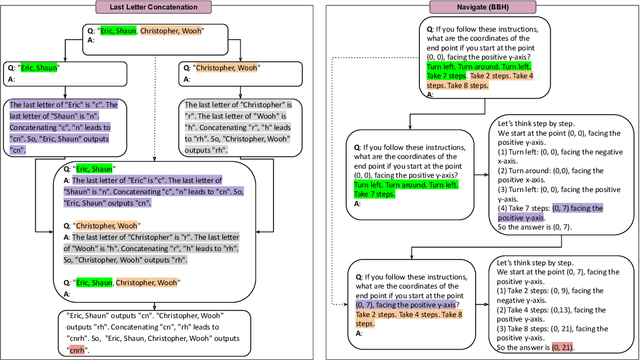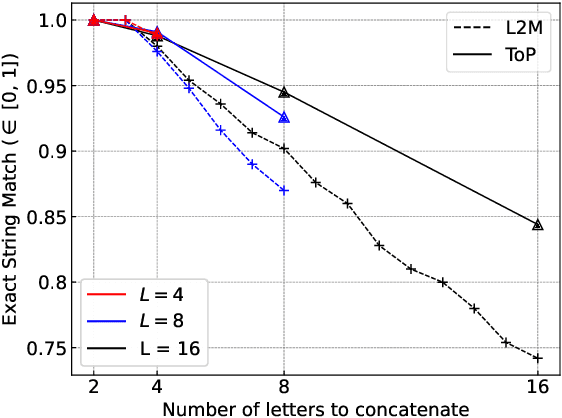Rachel Bawden
Explicit Learning and the LLM in Machine Translation
Mar 12, 2025Abstract:This study explores the capacity of large language models (LLMs) for explicit learning, a process involving the assimilation of metalinguistic explanations to carry out language tasks. Using constructed languages generated by cryptographic means as controlled test environments, we designed experiments to assess an LLM's ability to explicitly learn and apply grammar rules. Our results demonstrate that while LLMs possess a measurable capacity for explicit learning, this ability diminishes as the complexity of the linguistic phenomena at hand increases. Supervised fine-tuning on chains of thought significantly enhances LLM performance but struggles to generalize to typologically novel or more complex linguistic features. These findings point to the need for more diverse training sets and alternative fine-tuning strategies to further improve explicit learning by LLMs.
Compositional Translation: A Novel LLM-based Approach for Low-resource Machine Translation
Mar 06, 2025Abstract:The ability of generative large language models (LLMs) to perform in-context learning has given rise to a large body of research into how best to prompt models for various natural language processing tasks. Machine Translation (MT) has been shown to benefit from in-context examples, in particular when they are semantically similar to the sentence to translate. In this paper, we propose a new LLM-based translation paradigm, compositional translation, to replace naive few-shot MT with similarity-based demonstrations. An LLM is used to decompose a sentence into simpler phrases, and then to translate each phrase with the help of retrieved demonstrations. Finally, the LLM is prompted to translate the initial sentence with the help of the self-generated phrase-translation pairs. Our intuition is that this approach should improve translation because these shorter phrases should be intrinsically easier to translate and easier to match with relevant examples. This is especially beneficial in low-resource scenarios, and more generally whenever the selection pool is small or out of domain. We show that compositional translation boosts LLM translation performance on a wide range of popular MT benchmarks, including FLORES 200, NTREX 128 and TICO-19. Code and outputs are available at https://github.com/ArmelRandy/compositional-translation
AFRIDOC-MT: Document-level MT Corpus for African Languages
Jan 10, 2025



Abstract:This paper introduces AFRIDOC-MT, a document-level multi-parallel translation dataset covering English and five African languages: Amharic, Hausa, Swahili, Yor\`ub\'a, and Zulu. The dataset comprises 334 health and 271 information technology news documents, all human-translated from English to these languages. We conduct document-level translation benchmark experiments by evaluating neural machine translation (NMT) models and large language models (LLMs) for translations between English and these languages, at both the sentence and pseudo-document levels. These outputs are realigned to form complete documents for evaluation. Our results indicate that NLLB-200 achieved the best average performance among the standard NMT models, while GPT-4o outperformed general-purpose LLMs. Fine-tuning selected models led to substantial performance gains, but models trained on sentences struggled to generalize effectively to longer documents. Furthermore, our analysis reveals that some LLMs exhibit issues such as under-generation, repetition of words or phrases, and off-target translations, especially for African languages.
Investigating Length Issues in Document-level Machine Translation
Dec 23, 2024Abstract:Transformer architectures are increasingly effective at processing and generating very long chunks of texts, opening new perspectives for document-level machine translation (MT). In this work, we challenge the ability of MT systems to handle texts comprising up to several thousands of tokens. We design and implement a new approach designed to precisely measure the effect of length increments on MT outputs. Our experiments with two representative architectures unambiguously show that (a)~translation performance decreases with the length of the input text; (b)~the position of sentences within the document matters and translation quality is higher for sentences occurring earlier in a document. We further show that manipulating the distribution of document lengths and of positional embeddings only marginally mitigates such problems. Our results suggest that even though document-level MT is computationally feasible, it does not yet match the performance of sentence-based MT.
Tree of Problems: Improving structured problem solving with compositionality
Oct 09, 2024



Abstract:Large Language Models (LLMs) have demonstrated remarkable performance across multiple tasks through in-context learning. For complex reasoning tasks that require step-by-step thinking, Chain-of-Thought (CoT) prompting has given impressive results, especially when combined with self-consistency. Nonetheless, some tasks remain particularly difficult for LLMs to solve. Tree of Thoughts (ToT) and Graph of Thoughts (GoT) emerged as alternatives, dividing the complex problem into paths of subproblems. In this paper, we propose Tree of Problems (ToP), a simpler version of ToT, which we hypothesise can work better for complex tasks that can be divided into identical subtasks. Our empirical results show that our approach outperforms ToT and GoT, and in addition performs better than CoT on complex reasoning tasks. All code for this paper is publicly available here: https://github.com/ArmelRandy/tree-of-problems.
In-Context Example Selection via Similarity Search Improves Low-Resource Machine Translation
Aug 01, 2024Abstract:The ability of generative large language models (LLMs) to perform in-context learning has given rise to a large body of research into how best to prompt models for various natural language processing tasks. In this paper, we focus on machine translation (MT), a task that has been shown to benefit from in-context translation examples. However no systematic studies have been published on how best to select examples, and mixed results have been reported on the usefulness of similarity-based selection over random selection. We provide a study covering multiple LLMs and multiple in-context example retrieval strategies, comparing multilingual sentence embeddings. We cover several language directions, representing different levels of language resourcedness (English into French, German, Swahili and Wolof). Contrarily to previously published results, we find that sentence embedding similarity can improve MT, especially for low-resource language directions, and discuss the balance between selection pool diversity and quality. We also highlight potential problems with the evaluation of LLM-based MT and suggest a more appropriate evaluation protocol, adapting the COMET metric to the evaluation of LLMs. Code and outputs are freely available at https://github.com/ArmelRandy/ICL-MT.
Preliminary WMT24 Ranking of General MT Systems and LLMs
Jul 29, 2024



Abstract:This is the preliminary ranking of WMT24 General MT systems based on automatic metrics. The official ranking will be a human evaluation, which is superior to the automatic ranking and supersedes it. The purpose of this report is not to interpret any findings but only provide preliminary results to the participants of the General MT task that may be useful during the writing of the system submission.
Towards Zero-Shot Multimodal Machine Translation
Jul 18, 2024Abstract:Current multimodal machine translation (MMT) systems rely on fully supervised data (i.e models are trained on sentences with their translations and accompanying images). However, this type of data is costly to collect, limiting the extension of MMT to other language pairs for which such data does not exist. In this work, we propose a method to bypass the need for fully supervised data to train MMT systems, using multimodal English data only. Our method, called ZeroMMT, consists in adapting a strong text-only machine translation (MT) model by training it on a mixture of two objectives: visually conditioned masked language modelling and the Kullback-Leibler divergence between the original and new MMT outputs. We evaluate on standard MMT benchmarks and the recently released CoMMuTE, a contrastive benchmark aiming to evaluate how well models use images to disambiguate English sentences. We obtain disambiguation performance close to state-of-the-art MMT models trained additionally on fully supervised examples. To prove that our method generalizes to languages with no fully supervised training data available, we extend the CoMMuTE evaluation dataset to three new languages: Arabic, Russian and Chinese. We further show that we can control the trade-off between disambiguation capabilities and translation fidelity at inference time using classifier-free guidance and without any additional data. Our code, data and trained models are publicly accessible.
mOSCAR: A Large-scale Multilingual and Multimodal Document-level Corpus
Jun 13, 2024



Abstract:Multimodal Large Language Models (mLLMs) are trained on a large amount of text-image data. While most mLLMs are trained on caption-like data only, Alayrac et al. [2022] showed that additionally training them on interleaved sequences of text and images can lead to the emergence of in-context learning capabilities. However, the dataset they used, M3W, is not public and is only in English. There have been attempts to reproduce their results but the released datasets are English-only. In contrast, current multilingual and multimodal datasets are either composed of caption-like only or medium-scale or fully private data. This limits mLLM research for the 7,000 other languages spoken in the world. We therefore introduce mOSCAR, to the best of our knowledge the first large-scale multilingual and multimodal document corpus crawled from the web. It covers 163 languages, 315M documents, 214B tokens and 1.2B images. We carefully conduct a set of filtering and evaluation steps to make sure mOSCAR is sufficiently safe, diverse and of good quality. We additionally train two types of multilingual model to prove the benefits of mOSCAR: (1) a model trained on a subset of mOSCAR and captioning data and (2) a model train on captioning data only. The model additionally trained on mOSCAR shows a strong boost in few-shot learning performance across various multilingual image-text tasks and benchmarks, confirming previous findings for English-only mLLMs.
Making Sentence Embeddings Robust to User-Generated Content
Mar 25, 2024Abstract:NLP models have been known to perform poorly on user-generated content (UGC), mainly because it presents a lot of lexical variations and deviates from the standard texts on which most of these models were trained. In this work, we focus on the robustness of LASER, a sentence embedding model, to UGC data. We evaluate this robustness by LASER's ability to represent non-standard sentences and their standard counterparts close to each other in the embedding space. Inspired by previous works extending LASER to other languages and modalities, we propose RoLASER, a robust English encoder trained using a teacher-student approach to reduce the distances between the representations of standard and UGC sentences. We show that with training only on standard and synthetic UGC-like data, RoLASER significantly improves LASER's robustness to both natural and artificial UGC data by achieving up to 2x and 11x better scores. We also perform a fine-grained analysis on artificial UGC data and find that our model greatly outperforms LASER on its most challenging UGC phenomena such as keyboard typos and social media abbreviations. Evaluation on downstream tasks shows that RoLASER performs comparably to or better than LASER on standard data, while consistently outperforming it on UGC data.
 Add to Chrome
Add to Chrome Add to Firefox
Add to Firefox Add to Edge
Add to Edge